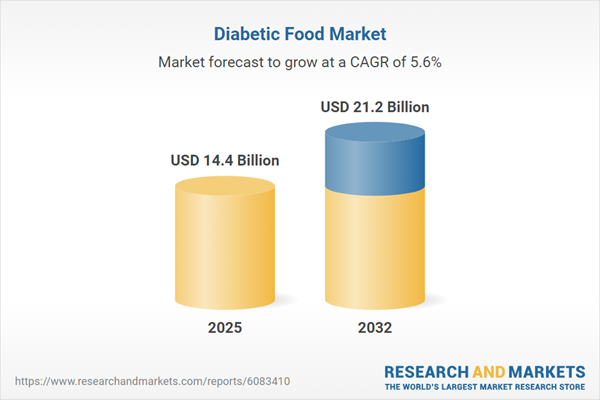Speak directly to the analyst to clarify any post sales queries you may have.
The diabetic food market is experiencing accelerated innovation and sophisticated segmentation, propelled by lifestyle changes, evolving nutritional expectations, and technological integration. Senior executives require a precise understanding of shifting consumer behaviors and regulatory landscapes shaping this sector.
Market Snapshot: Diabetic Food Market Growth and Drivers
The Diabetic Food Market grew from USD 13.67 billion in 2024 to USD 14.40 billion in 2025. It is expected to continue growing at a CAGR of 5.63%, reaching USD 21.20 billion by 2032. Key growth is fueled by increased global diabetes prevalence, rising health consciousness, continuous product development, and advancements in digital health monitoring. Leading manufacturers and ingredient suppliers are developing solutions designed for improved glycemic control, reflecting the sector’s strong response to changing consumer and regulatory demands.
Scope & Segmentation
- Product Types: Baked goods (bread, cakes, cookies), confectionery (candies, chocolates), dairy products (cheese, milk, yogurts), snacks (chips, crackers, nuts).
- Ingredient Types: Artificial sweeteners, natural sweeteners, nuts and seeds, whole grains.
- Packaging Types: Boxes, cans, jars, pouches for optimized shelf life and convenience.
- Diet Types: Gluten-free, ketogenic, low-glycemic, vegan formats meeting diverse dietary needs.
- Distribution Channels: Offline retailers (pharmacies, specialty stores, supermarkets, hypermarkets) and online platforms (company websites, e-commerce).
- End-User Groups: Products designed for diabetic patients, non-diabetic patients, and pre-diabetic individuals, enabling tailored nutrition strategies.
- Regional Coverage: Americas (United States, Canada, Mexico, Brazil, Argentina, Chile, Colombia, Peru), Europe, Middle East & Africa (United Kingdom, Germany, France, Russia, Italy, Spain, Netherlands, Sweden, Poland, Switzerland, United Arab Emirates, Saudi Arabia, Qatar, Turkey, Israel, South Africa, Nigeria, Egypt, Kenya), Asia-Pacific (China, India, Japan, Australia, South Korea, Indonesia, Thailand, Malaysia, Singapore, Taiwan).
- Companies Profiled: Abbott Laboratories, Adani Group, Amy’s Kitchen, Archer Daniels Midland, Beneo GmbH, Cargill, Danone, Fifty 50 Foods, General Mills, Hain Celestial Group, Ingredion, Kellogg, Mars, Mondelez, Nestlé, PepsiCo, Sriram Diabetic Foods, The Coca-Cola Company, The Hershey Company, The Kraft Heinz Company, Tyson Foods, Unilever, Vitalicious.
Key Takeaways for Senior Decision-Makers
- Personalized nutrition and data-driven platforms are driving product innovation, allowing companies to offer targeted diabetic food solutions based on consumer health data.
- Collaborations among food scientists, healthcare professionals, and digital health providers enhance clinical validation and market trust for new diabetic food offerings.
- The industry prioritizes clean-label and naturally sourced products, prompting new partnerships between specialty ingredient suppliers and established food companies.
- Digital health platforms and telemedicine accelerate consumer adoption and facilitate product integration with real-time glucose monitoring for improved user outcomes.
- Omnichannel strategies, combining traditional retail, specialty, and digital platforms, cater to diverse consumer access points and reinforce brand engagement.
- Regional trends reveal tailored approaches: Americas benefit from advanced R&D alliances, Europe faces strict health regulations, Asia-Pacific leverages e-commerce and local dietary influence.
Tariff Impact on Supply Chains and Pricing Strategies
Recent US tariff adjustments have reshaped sourcing and supply chain strategies in the diabetic food market. Manufacturers increasingly diversify suppliers and explore domestic processing to manage cost pressures and ensure stability. Strategic reformulation and proactive engagement with trade authorities are prevalent, particularly for companies dependent on imported specialized sweeteners. Flexible risk management is essential to safeguard supply continuity and moderate pricing volatility.
Research Methodology & Data Sources
This report applies a thorough combination of secondary research—including industry publications, academic studies, and regulatory filings—and primary research via interviews with endocrinologists, regulatory experts, and food industry leaders. Qualitative and quantitative data triangulation supports consistency and reliable insights, and trend mapping delivers a clear picture of evolving market dynamics.
Why This Report Matters
- Empowers executives with segmentation analysis, actionable recommendations, and competitive intelligence to inform product strategy and investment decisions.
- Clarifies the implications of regulatory changes, technological advances, and shifting consumer demand on supply chain and market positioning.
- Supports risk mitigation by outlining best practices for resilience in the face of trade volatility and regulatory shifts.
Conclusion
The diabetic food market’s trajectory is defined by personalized nutrition, regulatory alignment, and digital innovation. Companies embracing scientific validation and adaptable supply strategies are well-positioned to capture growth and ensure long-term value in a complex and evolving landscape.
Table of Contents
3. Executive Summary
4. Market Overview
7. Cumulative Impact of Artificial Intelligence 2025
Companies Mentioned
The companies profiled in this Diabetic Food market report include:- Abbott Laboratories
- Adani Group
- Amy’s Kitchen, Inc.
- Archer Daniels Midland Company
- Beneo GmbH
- Cargill, Incorporated
- Danone
- Fifty 50 Foods, Inc.
- General Mills, Inc.
- Hain Celestial Group
- Ingredion Incorporated
- Kellogg Company
- Mars Inc.
- Mondelez International, Inc.
- Nestlé S.A.
- PepsiCo Inc.
- Sriram Diabetic Foods
- The Coca-Cola Company
- The Hershey Company
- The Kraft Heinz Company
- Tyson Foods, Inc.
- Unilever PLC
- Vitalicious, Inc.
Table Information
| Report Attribute | Details |
|---|---|
| No. of Pages | 185 |
| Published | November 2025 |
| Forecast Period | 2025 - 2032 |
| Estimated Market Value ( USD | $ 14.4 Billion |
| Forecasted Market Value ( USD | $ 21.2 Billion |
| Compound Annual Growth Rate | 5.6% |
| Regions Covered | Global |
| No. of Companies Mentioned | 24 |









